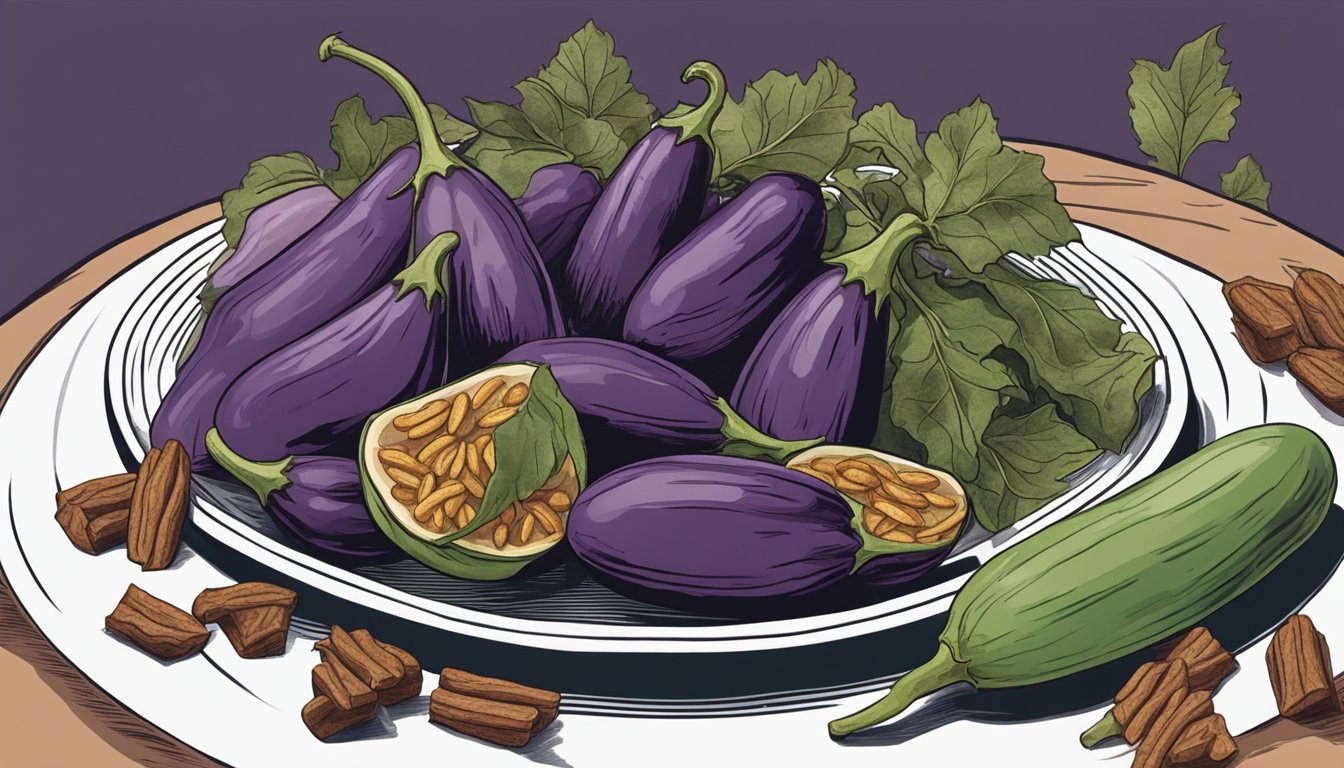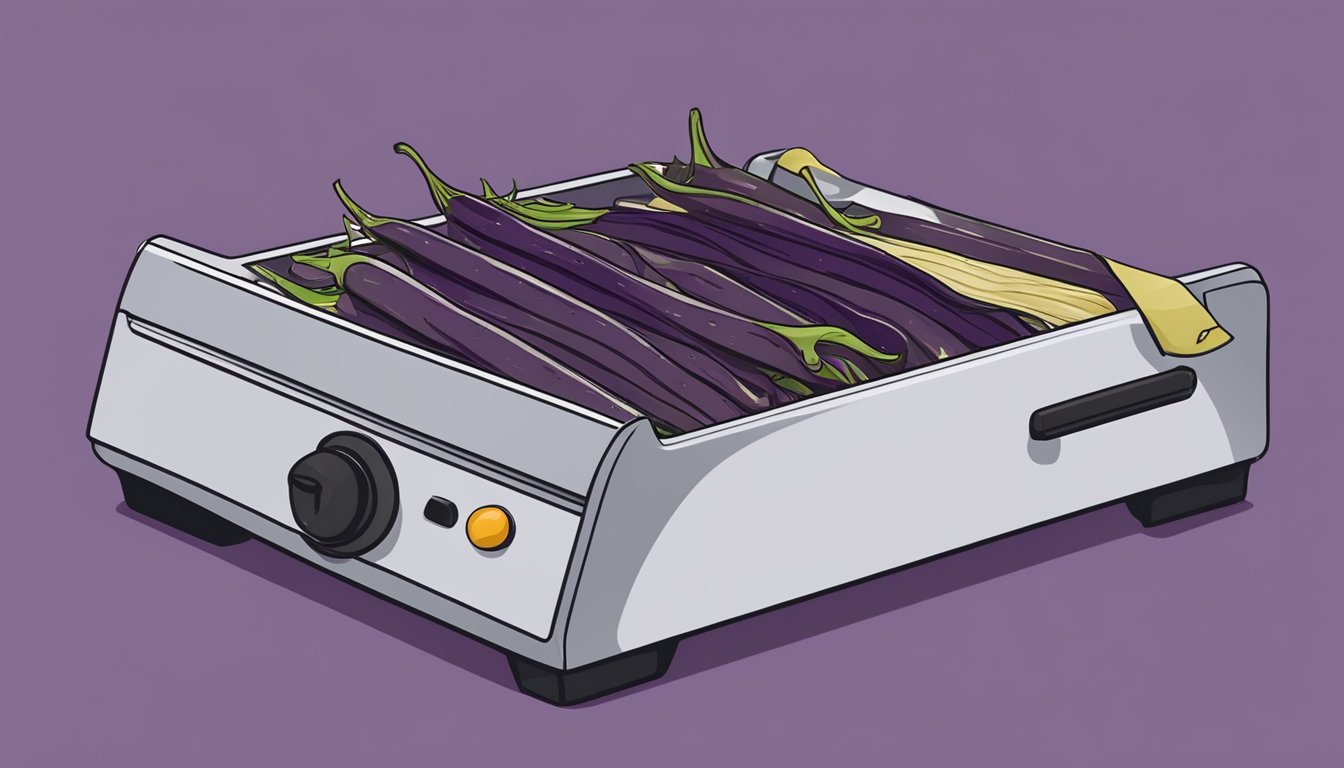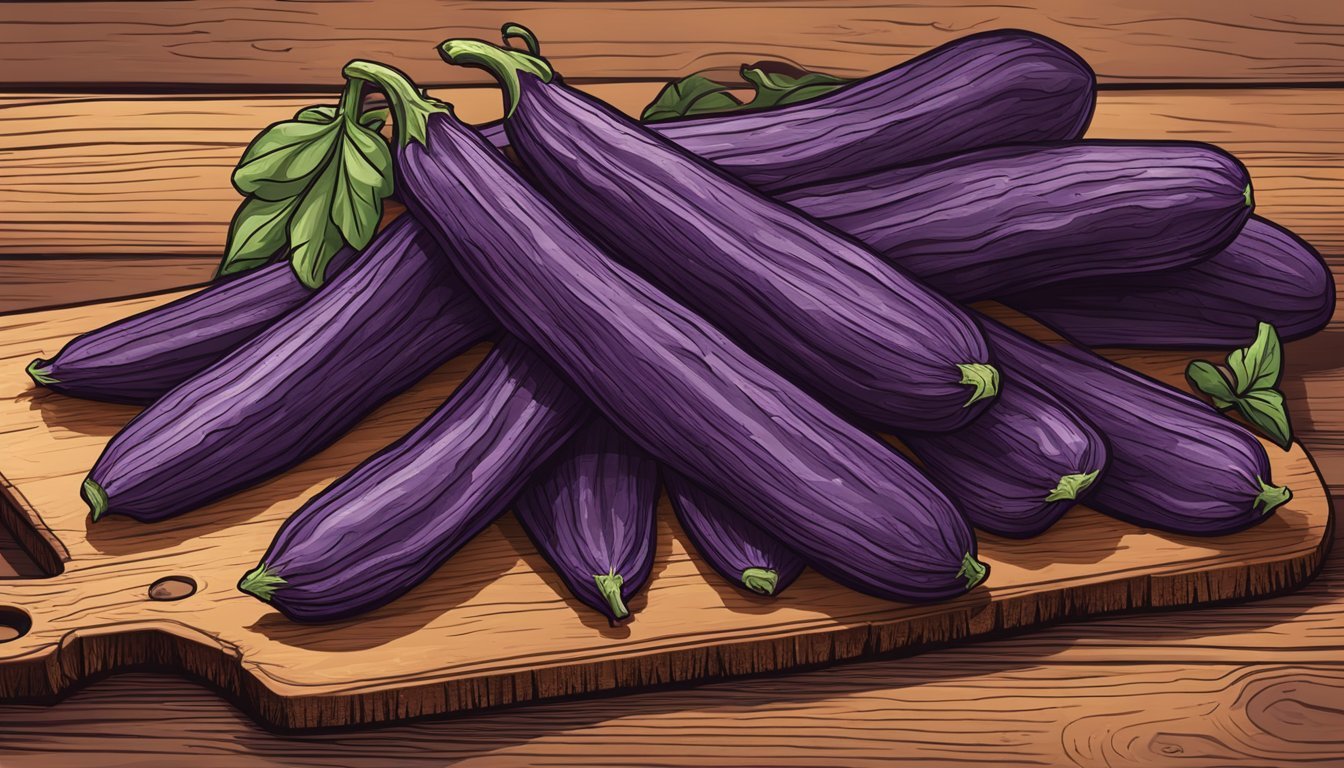Eggplant Peel Jerky
A Chewy, Smoky Snack Revolution in Healthy Eating
Eggplant (What wine goes well with eggplant?) peel jerky is emerging as a creative and sustainable way to enjoy a chewy, smoky snack. The process transforms the often-discarded skins of eggplants into a delectable treat with a rich, concentrated flavor that appeals to health-conscious consumers and snack enthusiasts alike. As interest in plant-based diets grows, eggplant jerky offers a nutritious alternative to traditional meat-based jerky, being low in calories and high in dietary fiber.
Making eggplant jerky involves slicing the vegetable and often using the peels to prepare the snack. It's a simple, yet precise, operation: the eggplant is cut, marinated to infuse it with flavors, and then dried slowly until a perfect chewy texture is achieved. The result is a snack that not only packs a savory punch but also aligns with a zero-waste lifestyle.
This snack's unique texture and taste have the potential to capture the snack market's attention. With the versatility of eggplant, the flavor profiles for eggplant jerky can range from sweet and tangy to intensely smoky or spicy, providing options for a wide array of palates. The appeal of eggplant jerky lies not only in its delicious taste but also in the inventive use of an ingredient that would otherwise go to waste, making it a smart choice for environmentally conscious snack fans.
Discovering the Basics of Eggplant Jerky
In the quest for healthier snack alternatives, eggplant jerky emerges as a standout choice, merging the benefits of plant-based ingredients with the satisfying chew of traditional jerky.
What Is Eggplant Jerky?
Eggplant jerky is a dehydrated snack made from thin slices of eggplant marinated in savory spices and sauces. Through a meticulous process of slicing, marinating, and slow-baking, the eggplant transforms into a chewy, flavorful treat. Various marinades can be used, often resembling those used for traditional beef jerky, to infuse the eggplant with bold flavors ranging from smoky to spicy.
Benefits of Eggplant as a Snack
The low-calorie nature of eggplant makes it an excellent base for jerky, offering an array of nutrients such as dietary fiber, vitamins, and minerals. This vegetable is:
Rich in antioxidants
High in fiber
Low in calories
As a snack, it provides a guilt-free option for those tracking their caloric intake while still delivering a satisfying chew reminiscent of meat-based snacks (What wine goes well with snacks?).
Comparing Eggplant Jerky to Beef Jerky
When it comes to evaluating eggplant jerky against beef jerky, several distinctions stand out:
Aspect Eggplant Jerky Beef Jerky Base ingredient Eggplant (vegetable) Beef (animal protein) Dietary alignment Vegan and vegetarian-friendly Not suitable for vegetarians Texture Chewy, varies depending on dehydration time and thickness Consistently chewy to tough Flavor profile Absorbs marinades; can vary widely Often smoky, salty, and savory Nutritional value Lower in protein; higher in fiber Higher in protein; lower in fiber
Eggplant jerky offers a versatile vegan alternative that caters to a broader range of dietary preferences, while providing a texture similar to that of beef jerky but with distinct plant-based benefits.
Selecting the Right Ingredients
In crafting eggplant peel jerky, the choice of ingredients is just as important as the preparation process. The right selection will lead to a chewy, smoky snack that bursts with flavor.
Choosing the Best Eggplants
The foundation of eggplant jerky is, of course, the eggplant itself. One should seek out firm, glossy eggplants with smooth skin and a uniform dark purple color. They should feel heavy for their size, indicating ample moisture, which is crucial for a chewy jerky texture after dehydration.
Essential Spices and Seasonings
Seasonings bring the eggplant to life, so using high-quality spices is key. Here is a list of essential seasonings:
Salt: A must for flavor enhancement; kosher or sea salt works best.
Pepper: Freshly ground black pepper adds a subtle heat.
Cayenne: This spice brings a kick to the jerky for those who enjoy a spicier taste.
Smoked Paprika: Imparts the signature smoky flavor integral to jerky.
Garlic: Fresh or powdered garlic contributes a zesty profile that pairs well with eggplant.
These seasonings should be adjusted according to personal taste, keeping in mind that flavors intensify after dehydration.
Alternative Ingredients for Special Diets
For those adhering to special dietary needs, alternative ingredients can be utilized without compromising flavor. Examples include:
Olive Oil: For a rich, smooth texture, one can opt for extra-virgin olive oil, which is a healthy fat and suitable for many diets, including gluten-free.
Gluten-Free Options: Ensure all sauces or added ingredients are certified gluten-free if catering to coeliac or gluten-sensitive diets.
It's essential to read labels carefully to ensure that all ingredients meet the dietary restrictions of intended consumers.
Preparation Techniques
Creating eggplant peel jerky involves meticulous preparation to ensure the final snack is chewy and smoky. Here we explore the foundational steps involving the initial prep of the eggplant, slicing with precision, and choosing a flavor-infusing marinade.
Initial Prep Work
Prep Time: To start, one should allocate a few hours for preparation and drying. The eggplant requires time to marinate and dehydrate properly to achieve the desired jerky texture. The initial prep involves thoroughly washing the eggplant to remove any dirt or residue.
Cutting Eggplant Slices Using a Mandolin
After washing, the eggplant can be uniformly sliced using a mandolin, which ensures consistently thin pieces that dehydrate evenly. To prepare:
Slice off the ends of the eggplant.
Safely use the mandolin to cut eggplant slices about 1/4 inch thick, which is ideal for jerky.
Note: It is critical for safety and uniformity to use the mandolin carefully and according to the manufacturer's instructions.
Selecting a Marinating Approach
The marinade imparts flavor and starts the softening process that results in the unique texture of jerky. One can opt for various marinade base ingredients such as:
Soy sauce: For a salty and umami flavor.
Balsamic vinegar: Adds a touch of acidity and sweetness.
The eggplant slices should be submerged or brushed with the chosen marinade and allowed to sit for at least 2 hours, which ensures the flavors penetrate deeply. Opting to lay the slices on parchment paper during this process helps to maintain an easy-to-clean workspace.
Flavoring Your Jerky
Crafting a delectable eggplant jerky involves a symphony of flavors that must marinate together to achieve the perfect balance of sweetness, smokiness, and spice. The key to an irresistible jerky lies in the marinade and the judicious use of seasoning to enhance the natural flavor of the eggplant.
Creating the Perfect Marinade
To create a foundation for the eggplant jerky, one begins with a rich marinade. The essentials include:
Liquid Ingredients: Apple cider vinegar for tanginess, and for those preferring a non-vegan option, honey can impart a subtle sweetness.
Seasonings: Paprika and black pepper not only add complexity but also contribute to the jerky's visually appealing color.
The secret is to let the eggplant slices absorb these flavors for a minimum of two hours, which softens them and allows the marinade to penetrate deeply.
Experimenting with Sweetness and Smoke
Achieving the ideal smoky sweetness involves a careful balance:
Sweet Agents: Maple syrup offers a robust, autumnal sweetness, while honey provides a lighter, floral note.
Smoky Flavor: Liquid smoke infuses the jerky with an authentic smoky taste, reminiscent of traditional jerky, without the need for actual smoking.
For the best results, these ingredients should be whisked together with the liquid base and seasonings before tossing in the eggplant slices.
Balancing Spices and Heat
To adjust the heat level, one can play with the following spices:
Gentle Warmth: Black pepper can bring a sharp, woody heat that is not overpowering.
Moderate Heat: Red pepper flakes introduce a more pronounced heat, suitable for those who enjoy a spicy kick.
Fiery Depth: Chili powder combines with other spices to deliver a smoky heat that builds with each bite.
A judicious hand will ensure the spicy elements do not overshadow the subtle notes of the marinade, creating a harmonious flavor profile for the eggplant jerky.
Drying Options and Techniques
Preparing eggplant jerky involves dehydrating the slices until they achieve a chewy texture. There are two primary methods for drying: using a food dehydrator or an oven.
Using a Dehydrator for Optimal Results
When using a food dehydrator, place the eggplant slices on the dehydrator trays, ensuring they do not overlap. A dehydrator provides a controlled environment with consistent temperature and air flow, which is advantageous for evenly drying the eggplant jerky. It typically takes about 4 to 6 hours at a lower temperature setting, usually around 135°F to 145°F. Uniformly thin slices result in more consistent drying times and textures.
Oven-Drying Method Explained
For those without a food dehydrator, an oven can suffice. The key here is to use a low temperature — typically around 175°F — and a rimmed baking sheet lined with a wire rack. The rimmed sheet catches any drips, while the rack allows air to circulate around the slices, drying them evenly. Position the eggplant on the rack in a single layer without touching. Oven-drying can take approximately 2 to 3 hours, and it's beneficial to flip the eggplant slices halfway through the drying process.
Cooking Guide and Timelines
Preparing eggplant jerky is a slow cooking process that requires patience and precision. The thickness of the eggplant slices and consistent monitoring during cooking are key to achieving the perfect chewy and smoky snack.
Determining Cook Time Based on Thickness
Thin slices (1/8 inch): Approximately 3-4 hours in the oven.
Medium slices (1/4 inch): Around 4-6 hours of drying time required.
Thick slices (1/2 inch): Can take upwards of 6+ hours for desired texture.
It's crucial for the cook to ensure the eggplant slices are cut uniformly to promote even drying. Using a wire rack helps to circulate air around the slices, aiding in consistent dehydration.
What to Expect During the Cooking Process
One can expect the total time to make eggplant jerky to range from 3 to 6 hours or more, depending on slice thickness and individual oven characteristics. The process involves:
Preparing a wire rack on a baking sheet.
Arranging the eggplant slices on the rack without overlapping.
Observing changes as the eggplant dries, becoming leathery and chewy.
During the cooking process, the eggplant slices will progressively reduce in size and concentrate in flavor, transforming into a hearty jerky-like snack. Checking the jerky periodically ensures that it does not over-dry or burn.
Serving and Pairing Suggestions
Eggplant peel jerky is a versatile snack that pairs well with a variety of flavors. Whether enjoyed on its own or with complementary snacks and beverages, it offers a satisfying experience.
Complementing Snacks and Dips
Eggplant peel jerky's chewy texture and smoky taste make it a perfect match for creamy dips. It's especially delightful when paired with:
Hummus: The smoothness of hummus contrasts nicely with the jerky's chewiness.
Nut Butters: A spread of almond or cashew butter on top can enhance its richness, suitable for a vegan snack option.
For those looking for a crunch, consider serving it alongside:
Crackers or Toast: These provide a pleasing textural contrast.
Assorted Nuts: They add a wholesome, nutritional element to the snacking experience.
Wine and Beverage Pairings
Choosing the right beverage can enhance the enjoyment of eggplant peel jerky. Considerations for pairings include:
Bold Red Wines: Options such as Merlot or Cabernet Sauvignon can match the smokiness of the jerky.
Craft Beer: A hoppy IPA or a rich Stout can align well with the robust flavors.
For non-alcoholic options, one may opt for:
Sparkling Water: A refreshing spritz can cleanse the palate between bites.
Herbal Tea: Teas like chamomile or peppermint subtly complement the smoky notes.
Storing and Preserving Eggplant Jerky
When eggplant is transformed into jerky, its shelf life is significantly extended, making it an ideal snack for storage. Ensuring that the dehydrated slices remain crispy is key to maintaining their quality over time.
Long-Term Storage Solutions
For optimal long-term storage, eggplant jerky should be kept in an airtight container. To maximize freshness, one can use vacuum-sealed bags which prevent air exposure and potential moisture ingress that can soften the jerky. Desiccant packets are useful for absorbing any excess moisture within the storage container. Store the containers in a cool, dark location to prevent any degradation of the jerky's texture and flavor due to light or heat.
Freezing and Refrigeration Tips
While freezing is not necessary for dehydrated goods, it is a viable option for extending the life of eggplant jerky even further. If choosing to freeze, wrap the jerky securely in plastic wrap or aluminum foil before placing it in a freezer-safe bag. This will guard against freezer burn. For refrigeration, ensure the snack is sealed in airtight containers or resealable bags to retain the jerky's crispness. Refrigeration can be particularly helpful in humid environments where food items are prone to moisture.
Nutritional Information
Eggplant peel jerky is a nutritional snack that offers a variety of health benefits, especially for those following a vegan diet. Its preparation retains many of the inherent nutrients found in eggplant, making it a wholesome choice.
Health Benefits and Dietary Considerations
Eggplant is inherently low in calories but rich in vitamins, minerals, and dietary fiber. When transformed into jerky, it provides a chewy, low-fat alternative to traditional meat jerky, making it suitable for vegan diets. The snack is also gluten-free and can be a good fit for those with certain dietary restrictions.
Nutrients in Eggplant Peel Jerky:
Calories: Eggplant is generally low in calories, and the dehydration process used in jerky-making does not significantly change this aspect.
Fiber: A good source of dietary fiber, important for digestive health.
Vitamins and Minerals: Contains vitamins C, K, and B6, as well as potassium and magnesium.
Antioxidants: Eggplants have compounds like nasunin and chlorogenic acid, which are known for their potent antioxidant properties.
One should note that the nutritional content can also be influenced by the marinade and added ingredients:
Marinade: Common ingredients such as soy sauce or olive oil can add extra flavor but also additional sodium or fats.
Added Ingredients: Spices and seasonings can enhance the antioxidant benefits; however, one should be wary of sugar content in sweetened varieties.
Considering these elements, eggplant peel jerky can be a nutritious addition for those seeking plant-based snack options with potential health benefits.









